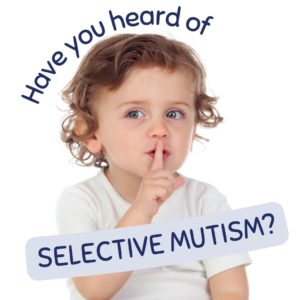Does your child seem shy or have trouble talking in certain situations?
Being shy is very normal and often eases as the child ages and matures. But what if your child truly is unable to speak in some situations?
This is called selective mutism.

Your child may have selective mutism if they:
- Speak in certain settings but stop talking, either completely or almost completely, when other people are around.
- Look frozen or paralyzed (like a “deer in the headlights”) or even angry when asked questions by strangers or when they feel uncomfortable.
- Use gestures like pointing, nodding, or funny facial expressions to get their needs met despite knowing how to talk.
Selective mutism generally shows up before the age of 5 but can persist and worsen as the child ages if not properly treated. It is considered a form of anxiety closely related to social anxiety disorder.
If your child is struggling, it is key to tap into support early. Not speaking can become ingrained as a way of coping, making it harder and harder to break the cycle. Once labelled socially, it is hard for the child to break that trajectory and can cause increasing isolation. Treatment for selective mutism is very similar to treatment for social anxiety, including cognitive behaviour therapy, gradual exposures, and contingency management.
Helping your child break this cycle early will help build confidence and hopefully minimize future struggles with social situations.